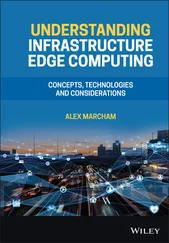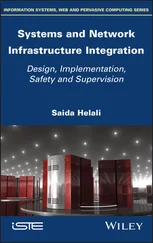Chris McCain - Mastering VMware® Infrastructure3
Здесь есть возможность читать онлайн «Chris McCain - Mastering VMware® Infrastructure3» — ознакомительный отрывок электронной книги совершенно бесплатно, а после прочтения отрывка купить полную версию. В некоторых случаях можно слушать аудио, скачать через торрент в формате fb2 и присутствует краткое содержание. Город: Indianapolis, Год выпуска: 2008, ISBN: 2008, Издательство: WILEY Wiley Publishing, Inc., Жанр: Программы, ОС и Сети, на английском языке. Описание произведения, (предисловие) а так же отзывы посетителей доступны на портале библиотеки ЛибКат.
- Название:Mastering VMware® Infrastructure3
- Автор:
- Издательство:WILEY Wiley Publishing, Inc.
- Жанр:
- Год:2008
- Город:Indianapolis
- ISBN:978-0-470-18313-7
- Рейтинг книги:5 / 5. Голосов: 1
-
Избранное:Добавить в избранное
- Отзывы:
-
Ваша оценка:
- 100
- 1
- 2
- 3
- 4
- 5
Mastering VMware® Infrastructure3: краткое содержание, описание и аннотация
Предлагаем к чтению аннотацию, описание, краткое содержание или предисловие (зависит от того, что написал сам автор книги «Mastering VMware® Infrastructure3»). Если вы не нашли необходимую информацию о книге — напишите в комментариях, мы постараемся отыскать её.
Mastering VMware® Infrastructure3 — читать онлайн ознакомительный отрывок
Ниже представлен текст книги, разбитый по страницам. Система сохранения места последней прочитанной страницы, позволяет с удобством читать онлайн бесплатно книгу «Mastering VMware® Infrastructure3», без необходимости каждый раз заново искать на чём Вы остановились. Поставьте закладку, и сможете в любой момент перейти на страницу, на которой закончили чтение.
Интервал:
Закладка:
Changing the number of ports in a virtual switch requires reboot of the ESX Server 3.5 host on which the virtual switch was altered.
Without an uplink, the internal-only vSwitch allows communication only between virtual machines that exist on the same ESX Server host. Virtual machines that communicate through an internal-only vSwitch do not pass any traffic through a physical adapter on the ESX Server host. As shown in Figure 3.4, communication between virtual machines connected to an internal-only switch takes place entirely in software and happens at whatever speed the VMkernel can perform the task.

Figure 3.4 Virtual machines communicating through an internal-only vSwitch do not pass any traffic through a physical adapter.
Virtual machines connected to an internal-only vSwitch are not VMotion capable. However, if the virtual machine is disconnected from the internal-only vSwitch, a warning will be provided but VMotion will succeed if all other requirements have been met. The requirements for VMotion will be covered in Chapter 9.
For virtual machines to communicate with resources beyond the virtual machines hosted on the local ESX server, a vSwitch must be configured to use a physical network adapter, or uplink. A vSwitch bound to a single physical adapter allows virtual machines to establish communication with physical servers on the network, or with virtual machines on other ESX Server hosts that are also connected to a vSwitch bound to a physical adapter. The vSwitch associated with a physical network adapter provides virtual machines with the amount of bandwidth the physical adapter is configured to support. For example, a vSwitch bound to a network adapter with a 1Gbps maximum speed will provide up to 1Gbps worth of bandwidth for the virtual machines connected to it. Figure 3.5 displays the communication path for virtual machines connected to a vSwitch bound to a single network adapter. In the diagram, when VM01 on silo104 needs to communicate with VM02 on silo105, the traffic from the virtual machine is passed through the ProductionLAN virtual switch (port group) in the VMkernel on silo104 to the physical network adapter to which the virtual switch is bound. From the physical network adapter, the traffic will reach the physical switch (PhySw1). The physical switch (PhySw1) passes the traffic to the second physical switch (PhySw2), which will pass the traffic through the physical network adapter associated with the Production-LAN virtual switch on silo105. In the last stage of the communication, the virtual switch will pass the traffic to the destination virtual machine VM02.
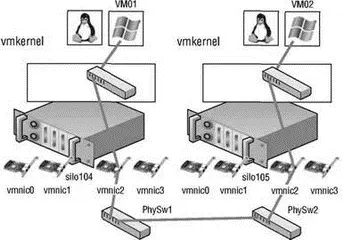
Figure 3.5The vSwitch with a single network adapter allows virtual machines to communicate with physical servers and other virtual machines on the network.
Discovering the network adapters, and even the networks they are connected to, is easy with the VI Client. While connected to a VirtualCenter server or an individual ESX Server host, the Network Adapters node of the Configuration tab of a host will display all the available adapters. The following image shows how each adapter will be listed with information about the model of the adapter, the vmnic# label, the speed and duplex setting, its association to a vSwitch, and a discovery of the IP addresses it has found on the network:
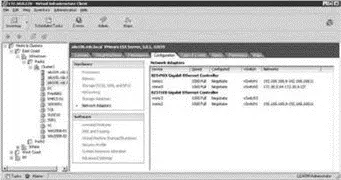
The network IP addresses listed under the Networks column are a result of a discovery across that network. The IP address range may change as new addresses are added and removed. For those NICs without a range, no IP addresses have been discovered. The network IP addresses should be used for information only and should be verified since they can be inaccurate.
The last type of virtual switch is referred to as a NIC team. As shown in Figure 3.6 and Figure 3.7, a NIC team involves the association of multiple physical network adapters with a single vSwitch. A vSwitch configured as a NIC team can consist of a maximum of 32 uplinks. In other words, a single vSwitch can use up to 32 physical network adapters to send and receive traffic from the physical switches. NIC teams offer the advantage of redundancy and load distribution. Later in this chapter, we will dig deeper into the configuration and workings of the NIC team.
Although a single vSwitch can be associated with multiple physical adapters as in a NIC team, a single physical adapter cannot be associated with multiple vSwitches. Pending the expansion capability, ESX Server 3.0.1 hosts can have up to 26 e100 network adapters, 32 e1000 network adapters, or 20 Broadcom network adapters. The maximum number of Ethernet ports on an ESX Server host is 32, regardless of the expansion slots or the number of adapters used to reach the maximum. For example, using eight quad-port NICs would achieve the 32-port maximum. All 32 ports could be configured for use by a single vSwitch or could be spread across multiple vSwitches.
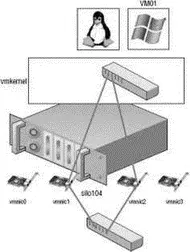
Figure 3.6A vSwitch with a NIC team has multiple available adapters for data transfer. A NIC team offers redundancy and load distribution.

Figure 3.7Virtual switches with a NIC team are identified by the multiple physical network adapters assigned to the vSwitch.
The vSwitch, as introduced in the first section of the chapter, allows several different types of communication, including communication to and from the Service Console, to and from the VMkernel, and between virtual machines. The type of communication provided by a vSwitch is dependent on the port (group), or connection type that is created on the switch. ESX Server hosts can have a maximum of 512 port groups, while the maximum number of ports (port groups) across all virtual switches is 4096.
During the virtual network design I am often asked why virtual switches should not be created with the largest number of ports to leave room to grow. To answer this question let's look at some calculations against the network maximums of an ESX Server 3.5 host.
The maximum number of ports in a virtual switch is 1016. The maximum number of ports across all switches on a host is 4096. This means that if virtual switches are created with the 1016 port maximum only 4 virtual switches can be created. If you're doing a quick calculation of 1016 x 4 and realizing it is not 4096, don't forget that virtual switches actually have 8 reserved ports. Therefore, the 1016 port switch actually has 1,024 ports. Calculate 1,024 x 4 and you will arrive at the 4096 port maximum for an ESX Server 3.5 host.
Create virtual switches with a number of ports to meet your goals. If you can anticipate growth it will save you from a seemingly needless reboot in the future should you have to alter the virtual switch, but if it comes to it, that is why we are thankful for VMotion. Virtual machines can be moved to another host in order to satisfy the rebooting needs of tasks like editing the number of ports on a virtual switch.
Читать дальшеИнтервал:
Закладка:
Похожие книги на «Mastering VMware® Infrastructure3»
Представляем Вашему вниманию похожие книги на «Mastering VMware® Infrastructure3» списком для выбора. Мы отобрали схожую по названию и смыслу литературу в надежде предоставить читателям больше вариантов отыскать новые, интересные, ещё непрочитанные произведения.
Обсуждение, отзывы о книге «Mastering VMware® Infrastructure3» и просто собственные мнения читателей. Оставьте ваши комментарии, напишите, что Вы думаете о произведении, его смысле или главных героях. Укажите что конкретно понравилось, а что нет, и почему Вы так считаете.








